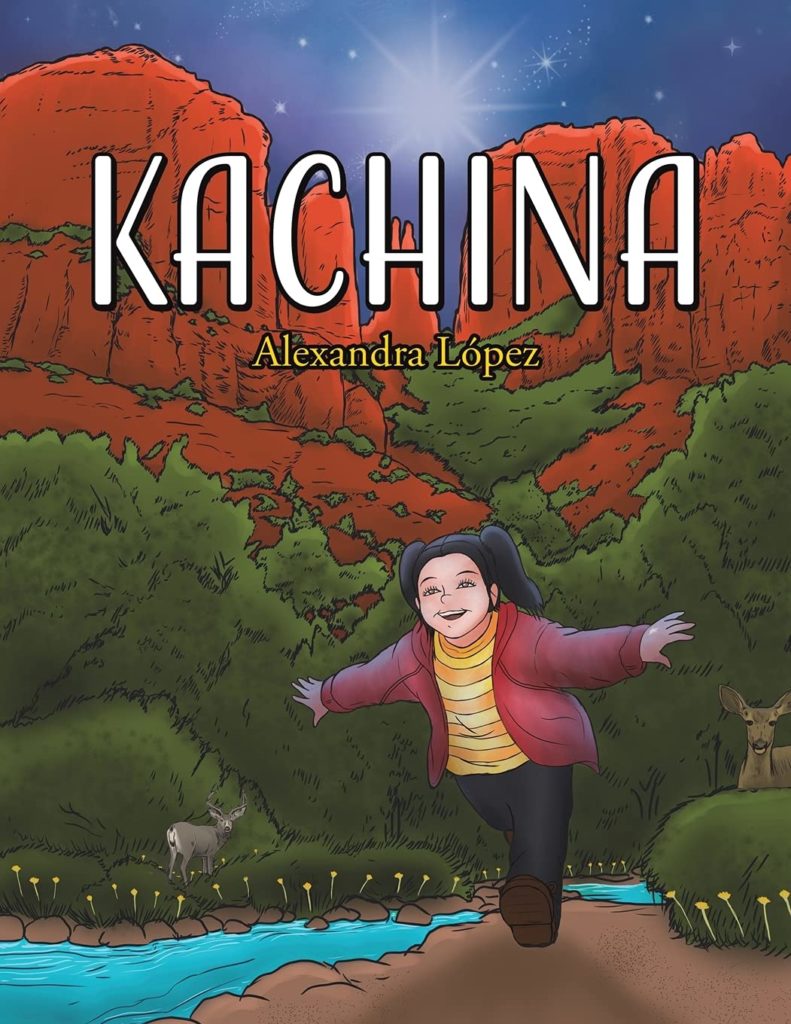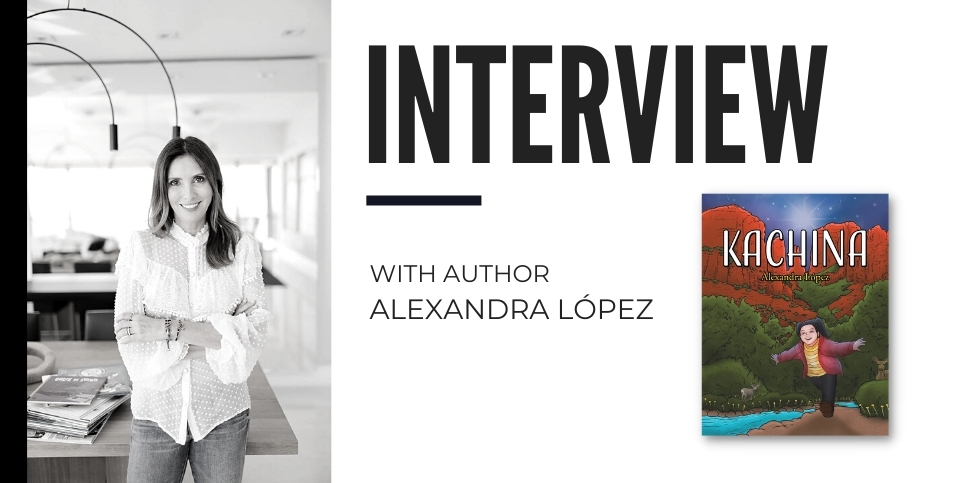The Children’s Book Review Interview in partnership with Alexandra López, author of Kachina
Alexandra López was born in Ecuador and spent her childhood in Venezuela. After studying French in Switzerland for a year, she moved to the United States to pursue her undergraduate and master’s degrees. Combining her passion for education and love for languages, she opened an English-speaking pre-school with a friend in Venezuela. The school has been operating for 25 years.
Alexandra now lives in Miami with her husband and four adult children. Writing children’s books that inspire children to reach their highest potential has always been her dream. In this interview, we discuss her book Kachina, a beautiful story about self-discovery and togetherness.
What prompted you to create a story about Kachina, and how did you decide what she would be like as a human being?
On a visit to Sedona, Arizona, a place that captivated me because of its breathtaking views, I sat down beside a red rock formation called Kachina Woman and thought about this story. While looking up at the stars and admiring their beauty, I imagined what a star looking down at Earth might wonder. I imagined a girl who could live around these beautiful red rocks and see this formation as a place for internalization, reflection, and an inner and outer connection through nature.
Why do you think this story is important for children to read?
I think it is important for children to read it because children can relate to Kachina. We all feel shame at some point in our life. Insecure about the things that make us feel creative because we are afraid of people making fun of us. We please others and choose to do the things that will make people love us, so we feel safe.
Through Kachina, I want children to feel connected to who they really are. And to not be afraid of being creative because others may judge them. I want them to feel confident that they can create the life they want, to have self-worth, self-love, and healthy self-esteem. Also, to be in touch with who they truly are.
Kachina thinks of not painting anymore but comes to see that she needs to do what makes her heart happy, and this is painting. Through the book, children can see that people can be mean because they are insecure about their abilities, like Hania feeling he is not good at drawing. Kachina shows her kindness by not being offended by Hania and, instead, wanting to show him how to draw.
The story also talks about humanity and how we all look different on the outside but are so similar on the inside. And that by getting along, there are many extraordinary things we humans can create. Through the book, children will feel close to nature, its beauty and see how we are all connected to our beautiful Earth.
In the story, Kachina’s art plays an important role in her journey. Why did you choose painting for her, rather than, say, music or dance?
I chose art because it is such a beautiful way of self-expression. Also, art can be done in a unique way, forcing you to trust yourself to paint. At the same time, art helps you connect with your uniqueness. Art confronts us with our insecurities because some people may like what you do and some may not.
Another blessing about painting is that it helps children communicate their emotions and feelings. It’s a form of self-expression without words. Painting can be a great platform for children to discover and explore their creativity.
Is Kachina based on a real artist?
Kachina is not based on a real artist. But I do see a life coach who Is also a painter. She has been a special person in my life. She shared that painting can be therapeutic because it allows your mind to focus on the present moment while allowing yourself to choose color, lines, and forms. It lets you connect with your imagination while you arrange the use of these materials. Anyone can identify with wanting to do something and feel insecure to a point where they prefer not to try.
Fear affects the development of children’s creativity. When you really love doing something, and someone criticizes you, it is very painful because you are receiving a rejection at a moment that you are exposing your true self to the world. I want children to feel that exposing this part of themselves is ok and that any rejection they receive has to do with the other person’s insecurities and with their own value.
Also, Hania was originally a part of Kachina that was always doubting herself and cruel to herself for doing what she loved. This part of her which was in her mind is her ego trying to tell her to stop painting because of the fear of being rejected by the people she loves and cares about.
We, as adults, still struggle with approval issues from our childhood that diminish our confidence. Most of us have a part of ourselves that is constantly criticizing us and it has its origin in our childhood. We need to confront and overcome this.
Kachina relies heavily on guides – both her mother and Great Mystery – as she learns. Who have been the important guides in your life, and are Kachina’s guides based on these influences?
Yes, Great Mystery and Kachina’s mother are important guides for Kachina as they push her to be herself and not worry about what others may think of her. They protect and encourage Kachina to make her feel she is capable.
I chose to include Great Mystery in the story as a higher source that we can all connect to. By not giving Great Mystery a name, I want to show that we have different spiritual paths as human beings. We can respect the beliefs that bring people peace and work together to create a world with more consciousness.
The idea of Kachina’s mother comes from something I have been working on with myself. This is trying to create loving maternal energy inside of me. I am learning to take care of my inner child’s needs giving her space in my life and treating her with love and kindness.
Tell us more about the metaphor of light that runs through the story. What does that light symbolize and how do you hope readers will interpret it?
We are all the same light in different colored body forms. We as human beings feel we are so different, but we are so similar. We are all trying to find happiness, peace, and purpose in life, even if we don’t consciously know it. Many of us separate ourselves from others based on religion, culture, and skin color, but I see us as stars who are on Earth to shine as we discover our true purpose.
What advice would you give a reader who feels she has lost her light?
I would tell them that without exception, we are all shining stars, energetic beings. When our light is dimmed, we need to be true to ourselves. We need to find what inspires us, what makes us light up, what makes our soul happy.
It’s important for me to let them know we all go through difficult times and times where we lose trust in ourselves. But we will become stronger from our difficulties and we will have so much more to share with others from what we have learned. We need to love ourselves and support ourselves with kind words every day because love gives us inner strength.
Do you plan to write more children’s books in the future? If so, will they teach similar lessons?
Yes, I hope to write many more children’s books because this is what I feel is my true purpose. I am trusting myself and writing what comes from my heart. I hope to write books that inspire children to identify their feelings, learn how to talk to themselves, and assert their self-esteem.

Kachina
Written by Alexandra López
Ages 4-8 | 36 Pages
Publisher: Austin Macauley Publishers | ISBN-13: 9791645753773
Imagine you are a star gazing down at Earth in wonder. For thousands of years, you see all the beauty in the world but you are not able to experience it. What would you do if you finally had the chance to become a human being and discover what you loved the most?
“Kachina is a beautiful and uplifting story, perfect for bedtime.” — The Children’s Book Review
Buy the Book
This interview—Alexandra López Discusses Kachina—was conducted between Alexandra López and Dr. Jen Harrison. For similar books and articles, follow along with our content tagged with Bedtime Stories, Bravery, Girl Empowerment, Picture Book, and Self-empowerment.

